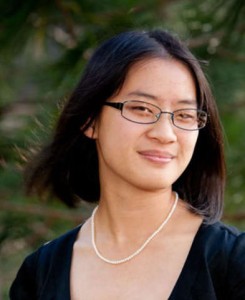
This summer, I worked on three different projects. For my primary project, I assisted Dave Carlon in his research on parrotfish speciation. Professor Carlon has found evidence of speciation through hybridization in parrotfish in the Pacific, and he and I extracted DNA from fin and scale samples and amplified specific genes (both nuclear and mitochondrial) using PCR. PCR, or polymerase chain reaction, is a biochemical technology used to amplify the number of copies of a particular stretch of DNA, generating thousands of copies of small pieces. We then confirmed the success of this amplification using gel electrophoresis. Once those initial steps were completed, we prepared samples and sent them away to have the specific genes sequenced. Genetic data was then analyzed in a computer program called Geneious. If, for example, we observed distinctly different patterns of similarity between the mitochondrial versus nuclear genes, that lent support to the hypothesis that some of our parrotfish species arose through hybridization. Speciation through hybridization has not been frequently observed in the wild, which is part of what made our project so interesting.

Additionally, I helped Aiden Short with his study of the diet of green crabs. He collected many crabs from several sites, and I helped him by dissecting them and collecting tissue samples. We collected muscle samples from their claws and then remove their entire stomachs. Aiden used next generation sequencing to discern what the crabs were eating and in what quantity–an improvement from the old technique which mostly consisted of looking at their stomach contents under a microscope–and he used the claw muscle as a safeguard to ensure that he wasn’t including the crabs’ own DNA in his analysis of their stomach contents. His project was especially interesting because green crabs are an invasive species here in Maine, and they’ve been implicated in the decline in quality of our eelgrass beds and possibly even soft shell clam populations. (Soft shell clams are economically important to our state, and eelgrass beds have huge environmental importance.)

Finally, I assisted Sarah Kingston in her study of calcification rates in blue mussels. Sarah collected blue mussels from various sites, labeled each individual mussel, and took the mass of the mussels. Then she divided the muscles into different tanks held at different temperatures and acidities. Her schemes were selected to simulate likely conditions under climate change. At the end of her testing period, she collected all the muscles, reweighed them to see how the masses of their shells changed (calcification rates), and took tissue samples from every mussel. We spent three days opening the mussels and collecting their feet and adductor muscles. One likely use of the tissue samples will be to look for connections between their genomes and responses to different temperature and pH schemes. I also assisted in further sample collections with the mussels and acted as mussel caretaker, feeding them and recording day-to-day information about temperature, pH, CO2 concentration, and so on.
Working for the Marine Lab this summer, and on such a wide variety of projects, was very rewarding. This experience has inspired me to pursue more research opportunities in the future.